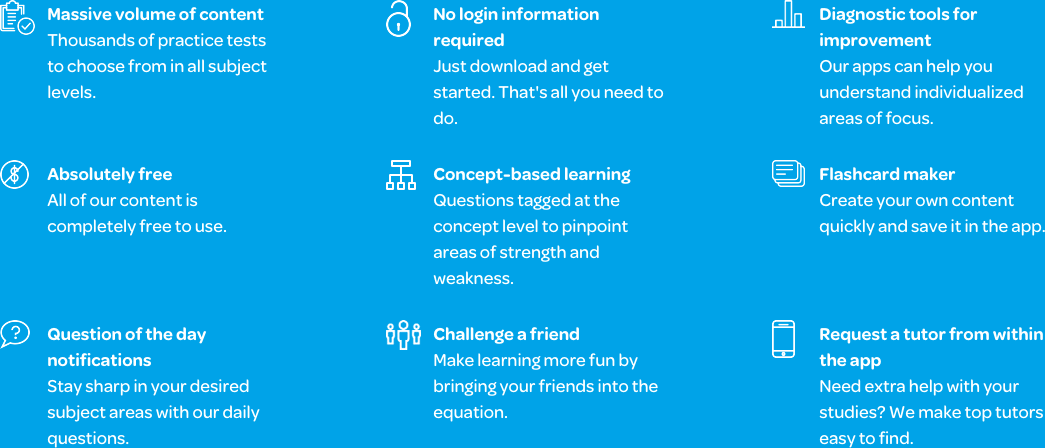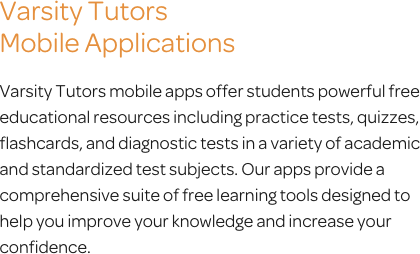The Varsity Tutors AP Physics 1 Mobile App
Varsity Tutors’ Learning Tools provides the AP Physics 1 app for iOS and Android, which can help you better grasp the concepts you learn in class and prepare for the exam. The introductory college-level physics course is entirely algebra-based. It’s important to realize you will have to master your algebra, geometry, and trigonometry skills as well as science. In the course, algebraic equations and expressions are used to solve problems related to work, energy and power, circuits, waves, sound, and Newtonian mechanics.
AP Physics 1 also provides you with laboratory experience. About 25 percent of the course involves hands-on lab work, which includes inquiry-based investigations. These teach you how to apply the science concepts learned. You will also make observations and predictions, construct arguments, and analyze data. Scientific explanations and theories are part of the course, and you’ll have to work with these in proper contexts as well.
The principles, theories, and ideas outlined in the underlying big ideas of the course must be understood for you to succeed. With the proper practice, you can become proficient in all areas of the course and maximize your chances of success on the exam. The big ideas include the mass and charge of objects and systems, interactions resulting from fields, interactions of objects with other objects due to forces, and how interactions result in changes. Another big idea addresses changes that result from interactions but are constrained by known conservation laws. The final idea covers how waves transfer energy and momentum, from one place to another, without permanently transferring mass. Waves are a fundamental physics concept and are where mathematical models are generated to describe a variety of phenomena.
On the AP Physics 1 exam, you will need to answer 50 multiple-choice questions in 90 minutes. This first section includes discrete items, items in set, and questions in which there are two correct answers. The free-response section has five questions, covering experimental design, quantitative and qualitative translation, and short answers. There are 90 minutes allotted for this section.
The exam can challenge you both intellectually and psychologically. Your confidence can have a big impact on how well you do. The AP Physics 1 app from the Learning Tools includes different exercises to test your knowledge and skills and to help you improve upon any weak areas. Full-Length Practice Tests, which are designed to mimic the actual exam, enable you to spend the time to cover all the topics included on the exam. They allow you to move from one concept to another and review your performance immediately afterward. A detailed analysis is provided, which includes your scoring, timing, and how you did in comparison to other test-takers, plus explanations for the answers. A review of these can help you study more effectively, and even save time.
Shorter topic-specific practice exercises that offer the same detailed analysis as their full length counterparts are also available. There is also a Question of the Day, selected at random each day, to help you get in a quick review at your convenience. With the Learn by Concept interactive syllabus, you can choose specific topics and sub-sections to review a series of questions and answers/explanations on each, covering as much ground as you need. Flashcards offer a pre-configured or customized approach to quickly review as many topics as you have time for. With these tools, you can review relevant content and focus on your weakest areas to build them into strengths.
The Varsity Tutors AP Physics I app for iPad, iPhone, or Android is available on the Google Play Store and iTunes. To get the most out of your AP Physics 1 study sessions, download yours today.
66 mobile apps to choose from for your tutoring needs.

Learn More
Advanced Placement (AP) Physics 1 is the first of four physics courses offered at the AP level. AP Physics 1 is the equivalent of an introductory, first-semester college-level physics course. It is an algebra-based class, and students will examine concepts like work, energy, power, Newtonian mechanics (in particular, rotational motion), mechanical waves and sound, and simple circuits. This is an ideal course for students who are interested in demonstrating their interest and proficiency in physics to potential colleges. One great way to prepare for this exam anywhere and at any time is with the Varsity Tutors AP Physics 1 app for iPhones, iPads, and Android devices.
AP Physics 1 has no formal prerequisites; however, students who opt to enroll in this course should have successfully completed both geometry and upper-level algebra. It is also helpful if students have a basic familiarity with trigonometry, but the trigonometric functions used in AP Physics 1 can easily be mastered within the course itself. The class also involves inquiry-based, hands-on lab work. One-quarter of the total course time is devoted to these investigations, which ask students to question, observe and predict, design, analyze, and reason in both group and individual experiments. These exercises also give students the opportunity to master best science practices.
Students in AP Physics 1 are also expected to establish solid scientific practices. They will develop and refine predictions and testable explanations of natural phenomena through the use of solid lines of evidence. Students should, at the end of the course, be adept at using mathematics, representations, and models to problem-solve and communicate. They must also have mastered the skills involved in data collection strategies, data analysis and evaluation, and effective scientific questioning. Perhaps the most important of all scientific practices, students in AP Physics 1 will be expected to form connections between and among concepts, representations, and scales across a wide variety of domains. Students who can demonstrate their ability to synthesize the material will be well on their way toward success, in both the classwork and on the AP exam.
The curriculum of AP Physics 1 is based upon six concepts, which help students to develop a well-rounded way of thinking about physics. By focusing on big-picture ideas, students are able to spend the majority of class time learning essential concepts through inquiry-based instruction. Since students spend less time engaged in routine mathematics, they are able to deepen their skills in critical thinking and reasoning. Each of the six “Big Ideas” involves foundational scientific theories, principles, and processes, and all of them are covered by the Varsity Tutors AP Physics 1 app, available for free download from iTunes and the Google Play Store.
The first Big Idea of AP Physics 1 is that systems and objects have properties like charge and mass. Additionally, these systems may have internal structure, which can determine a variety of properties of the system. These systems and objects also have properties of gravitational and inertial mass that are verifiable and conservationally sound. The second Big Idea is that interactions can be explained using fields existing in space. Students will learn to use field models to describe distant interactions and many other phenomena. Gravitational and electric fields are also discussed within this unit, and the different methods of mapping points to visualize scalar fields are covered, too.
Third, AP Physics 1 covers the Big Ideas involved in the forces that can be used to describe an object’s interaction with other objects. Students will view forces through the lens of an inertial reference frame, and evaluate their common characteristics. Newton’s second law is introduced here, as is the idea that the momentum and kinetic energy of an object can be altered by a force exerted on that object. The fourth Big Idea delves into the interactions between systems that change the systems. The concepts learned in the previous unit regarding interactions will be applied to systems as a whole, and changes in their total energy and linear momentum will be covered.
The fifth Big Idea explores conservation laws’ effect on constraining the changes that happen as a result of interactions. Students will learn about the conservation of a system’s electric charge, linear momentum, and angular momentum. The final Big Idea addresses the phenomenon of waves’ transfer of energy and momentum without permanently transferring mass, which will also be used as a model to describe other phenomena. Students will learn to differentiate among different types of waves and be able to describe the effects of a wave’s wavelength, speed, frequency, energy, and amplitude. Other unique characteristics of waves are also discussed in this unit, including interference, diffraction, standing waves, and beats.
The AP Physics 1 Exam is three hours long, and may touch upon any of the concepts learned over the span of the course. The exam will require students to problem-solve both mathematically and symbolically, analyze data through self-designed experiments they must be able to explain, use a comprehensive, complex understanding of concepts to justify their answers, and develop and interpret conceptual models. The exam is divided into two sections, both of which make up half of the total exam score. Section I consists of 50 multiple-choice questions that must be answered within 90 minutes. The questions will deal with discrete items and items in sets, and there will also be questions that ask students to select two correct options. Section II is made up of five free-response questions. One question will deal with experimental design, and another with qualitative and quantitative translation. There are three short answer questions as well, and one will require a response of at least one paragraph. These must also be answered within a 90-minute time period. With the free Varsity Tutors AP Physics 1 app for iOS and Android devices, you can drill every topic on the exam or take full-length practice tests that mimic the exam structure.
For students who are applying at particularly competitive post-secondary institutions, taking AP Physics 1 is an excellent way to showcase their skills. Plus, a strong performance on the AP Physics 1 Exam can provide students with a variety of benefits, which makes mastering the course material well worth the effort. Many colleges and universities will grant course credit for a high score on the exam, and it will also be taken into account when placing students into the appropriate course level. AP Physics 1 is a perfect introduction to college-level physics for students who are ready to learn the skills they’ll need to continue on in the AP Physics program. Are you ready? Then download the free Varsity Tutors AP Physics 1 app from iTunes or the Google Play Store today, and get started on your path towards success in physics.




